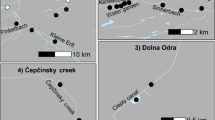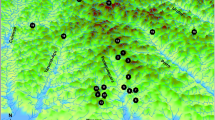Abstract
The introduction of the predatory land snail, Euglandina rosea (Férrusac, 1821) from Florida to Hawaii to control the giant African snail, Lissachatina fulica (Bowdich, 1822) is among the most publicized biological control cases gone awry. Following preliminary genetic analyses that revealed a second, possibly undescribed Euglandina species was probably introduced to Hawaii, we used an integrative systematic approach combining both genetic and morphological assessments to examine the taxonomic status of the snail referred to as E. rosea in Hawaii. Genetic and morphological analyses support the interpretation that two Euglandina species were introduced to and have become established in Hawaii and can be readily distinguished based on morphological differences. This finding has significant ramifications for understanding both historical and contemporary biocontrol as it suggests that: (1) other species may have been inadvertently introduced through bio-control programs, (2) inadequate understanding of the taxonomy of bio-control agents has obscured our ability to effectively study their ecological impacts, and (3) while the US has no comprehensive regulatory framework for importing biological control agents, one is urgently needed. This also has wide-ranging implications for conservation efforts throughout the tropics because Euglandina from Oahu, Hawaii were released on other Hawaiian Islands, New Guinea, Okinawa, Palau Islands, Philippines, India, Bonin Islands and Bermuda for use in biological control programs that led to catastrophic loss of endemic land snail diversity.

Similar content being viewed by others
References
Altschul SF, Gish W, Miller W, Myers EW, Lipman DJ (1990) Basic local alignment search tool. J Mol Biol 215:403–410
Auffenburg K, Stange LA (2001) Snails eating snails of Florida (Euglandina rosea (Ferussac 1831) (Gastropoda: Spiraxidae), Rumina decollate (Linnaeus 1758) (Gastropod: Subulinidae), Haplotrema concavum (Say 1821) (Gastropoda: Haplotrematidae), Gulella bicolor (Hutton 1834) (Gastropod: Streptaxidae), Varicella gracillima floridana (Pilsbry 1907) (Gastropoda: Oleacinidae). Florida Cooperative Extension Service, EENY-251
Bick CS, Foighil DÓ, Coote T (2016) Differential survival among Tahitian tree snails during a mass extinction event: persistence of the rare and fecund. Oryx 50:169–175
Bieler R, Slapcinsky J (2000) A case study for development of an island fauna: recent terrestrial mollusks of Bermuda. Nemouria 44:1–99
Bungartz F, Ziemmeck F, Tirado N, Jaramillo P, Herrera H, Jiménez-Uzcátegui G (2012) The neglected majority: biodiversity inventories as an integral part of conservation biology. In: Wolff M, Gardener M (eds) The role of science for conservation. Routledge, Oxon, pp 119–142
Castresana J (2000) Selection of conserved blocks from multiple alignments for their use in phylogenetic analysis. Mol Biol Evol 17:540–552
Chiba S, Cowie RH (2016) Evolution and extinction of land snails on oceanic islands. Annu Rev Ecol Evol Syst 47:123–141
Civeyrel L, Simberloff D (1996) A tale of two snails: is the cure worse than the disease? Biodivers Conserv 5:1231–1252
Cook A (1985a) The organization of feeding in the carnivorous snail Euglandina rosea. Malacologia 26:183–189
Cook A (1985b) Functional aspects of trail following by the carnivorous snail Euglandina rosea. Malacologia 26:173–181
Cook A (1989a) Factors affecting prey choice and feeding technique in the carnivorous snail Euglandina rosea Ferussac. J Molluscan Stud 55:469–477
Cook A (1989b) The basis of food choice by the carnivorous snail, Euglandina rosea. Br Counc Crop Prot Monogr 41:367–372
Coote T, Loève É (2003) From 61 species to five: endemic tree snails of the Society Islands fall prey to an ill-judged biological control progamme. Oryx 37:91–96
Cowie RH (2001a) Can snails ever be effective and safe biocontrol agents? Int J Pest Manage 47:23–40
Cowie RH (2001b) Invertebrate invasions on Pacific islands and the replacement of unique native faunas: a synthesis of the land and freshwater snails. Biol Invasions 3:119–136
Cowie RH, Evenhuis NL, Christensen CC (1995) Catalog of the native land and freshwater molluscs of the Hawaiian Islands. Backhuys Publishers, Leiden
Darriba D, Taboada GL, Doallo R, Posada D (2012) jModelTest 2: more models, new heuristics and parallel computing. Nat Methods 9:772
Davis CJ, Butler GD (1964) Introduced enemies of the giant African snail Achatina fulica Bowdich, in Hawaii (Pulmonata: Achatinidae). Proc Hawaii Entomol Soc 18:377–389
Davis EC, Perez KE, Bennett DJ (2004) Euglandina rosea (Férussac, 1821) is found on the ground and in trees in Florida. Nautilus 118:127–128
Davis-Berg EC (2012) The predatory snail Euglandina rosea successfully follows mucous trails of both native and non-native prey snails. Invertebr Biol 131:1–10
Davison A, Blackie RL, Scothern GP (2009) DNA barcoding of stylommatophoran land snails: a test of existing sequences. Mol Ecol Resour 9:1092–1101
Edgar RC (2004) MUSCLE: multiple sequence alignment with high accuracy and high throughput. Nucl Acids Res 32:1792–1797
Felsenstein J (1985) Confidence limits on phylogenies: an approach using the bootstrap. Evolution 39:783–791
Folmer O, Black M, Hoeh W, Lutz R, Vrijenhoek R (1994) DNA primers for amplification of mitochondrial cytochrome c oxidase subunit I from diverse metazoan invertebrates. Mol Mar Bio Tech 3:294–299
Garey JR, Krotec M, Nelson DR, Brooks J (1996) Molecular analysis supports a tardigrade-arthropod association. Invertebr Biol 115:79–88
Gerlach J (1999) The ecology of western Indian Ocean carnivorous land snails. Phelsuma 7:14–24
Granjou C, Mauz I, Barbier M, Breucker P (2014) Making taxonomy environmentally relevant: insights from an all taxa biodiversity inventory. Environ Sci Policy 38:254–262
Griffiths O, Cook A, Wells SM (1993) The diet of the introduced carnivorous snail Euglandina rosea in Mauritius and its implications for threatened island gastropod faunas. J Zool 229:79–89
Hadfield MG, Miller SE, Carwile AH (1993) The decimation of the endemic Hawai‘ian [sic] tree snails by alien predators. Am Zool 33:610–622
Holland BS, Christensen CC, Hayes KA, Cowie RH (2008) Biocontrol in Hawaii: a response to Messing (2007). Proc Hawaii Entomol Soc 40:81–83
Holland BS, Chock T, Lee A, Sugiura S (2012) Tracking behavior in the snail Euglandina rosea: first evidence of preference for endemic vs. biocontrol target pest species in Hawaii. Am Malacol Bull 30:153–157
Kearse M, Moir R, Wilson A, Stones-Havas S, Cheung M, Sturrock S, Buxton S, Cooper A, Markowitz S, Duran C, Thierer T (2012) Geneious Basic: an integrated and extendable desktop software platform for the organization and analysis of sequence data. Bioinformatics 28:1647–1649
Lydeard C, Cowie RH, Ponder WF, Bogan AE, Bouchet P, Clark SA, Cummings KS, Frest TJ, Gargominy O, Herbert DG, Hershler R (2004) The global decline of nonmarine mollusks. Bioscience 54:321–330
Messing RH, Wright MG (2006) Biological control of invasive species: solution or pollution. Front Ecol Environ 4:132–140
Meyer WM III, Cowie RH (2010) Feeding preferences of two predatory snails introduced to Hawaii and their conservation ramifications. Malacologia 53:135–144
Meyer WM III, Cowie RH (2011) Distribution, movement, and microhabitat use of the introduced predatory snail Euglandina rosea in Hawaii: implications for management. Invertebr Biol 130:325–333
Murray J, Murray E, Johnson MS, Clarke B (1988) The extinction of Partula on Moorea. Pac Sci 42:150–153
Pilsbry HA (1946) Land Mollusca of North America north of Mexico, vol II, part 1. Academy of Natural Sciences, Philadelphia
Régnier C, Fontaine B, Bouchet P (2009) Not knowing, not recording, not listing: numerous unnoticed mollusk extinctions. Conserv Biol 23:1214–1221
Régnier C, Bouchet P, Hayes KA, Yeung NW, Christensen CC, Chung DJ, Fontaine B, Cowie RH (2015) Extinction in a hyperdiverse endemic Hawaiian land snail family and implications for the underestimation of invertebrate extinction. Conserv Biol 29:1715–1723
Solem A (1990) How many Hawaiian land snail species are left? And what we can do for them. Bishop Mus Occas Pap 30:27–40
Stamatakis A (2014) RAxML version 8: a tool for phylogenetic analysis and post-analysis of large phylogenies. Bioinformatics 30:1312–1313
Stone R (1999) Keeping paradise safe for the natives. Science 285:1837
Suarez AV, Tsutsui ND (2004) The value of museum collections for research and society. Bioscience 54:66–74
Tamura K, Stecher G, Peterson D, Filipski A, Kumar S (2013) MEGA6: molecular evolutionary genetics analysis version 6.0. Mol Biol Evol 30:2725–2729
Tewksbury JJ, Anderson JG, Bakker JD, Billo TJ, Dunwiddie PW, Groom MJ, Hampton SE, Herman SG, Levey DJ, Machnicki NJ, Del Rio CM (2014) Natural history’s place in science and society. Bioscience 64:300–310
United States Department of Agriculture (USDA) (2015) Biological Control Program. https://www.aphis.usda.gov/wps/portal/aphis/ourfocus/planthealth/sa_domestic_pests_and_diseases/sa_bio_control/!ut/p/a0/04_Sj9CPykssy0xPLMnMz0vMAfGjzOK9_D2MDJ0MjDzd3V2dDDz93HwCzL29jAx8TfULsh0VAY_1WkE!/
Wen J, Ickert-Bond SM, Appelhans MS, Dorr LJ, Funk VA (2015) Collections-based systematics: opportunities and outlook for 2050. J Syst Evol 53:477–488
Acknowledgements
We thank D. Ressler, J. Kim, V. Costello, J. Tanino, B. Holland, S. Joe, T. Skelton, C. Tran, K. Bustamante, D. Gary, K. Leung, D. Robinson, D. Sischo and H. Walden for help in collection and processing of samples. We especially thank R.H. Cowie for lab support and helpful discussions. Funding and support was provided by U.S. Army Environmental, Oahu (WMM), the National Science Foundation (DEB-1120906, KAH) and the Smithsonian Institutes. This is contribution No. 2016–109 to the Hawaii Biological Survey and SOEST no. 9877 of the University of Hawaii’s School of Ocean and Earth Science and Technology.
Author information
Authors and Affiliations
Corresponding author
Electronic supplementary material
Below is the link to the electronic supplementary material.
Rights and permissions
About this article
Cite this article
Meyer, W.M., Yeung, N.W., Slapcinsky, J. et al. Two for one: inadvertent introduction of Euglandina species during failed bio-control efforts in Hawaii. Biol Invasions 19, 1399–1405 (2017). https://doi.org/10.1007/s10530-016-1354-4
Received:
Accepted:
Published:
Issue Date:
DOI: https://doi.org/10.1007/s10530-016-1354-4




